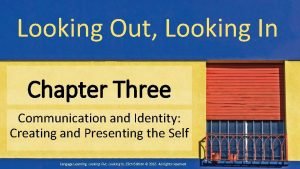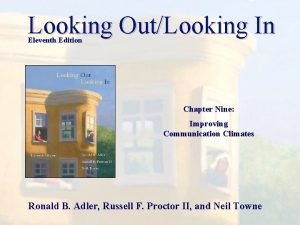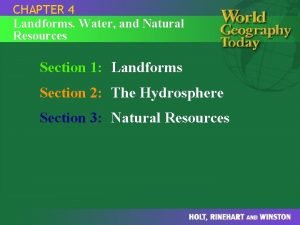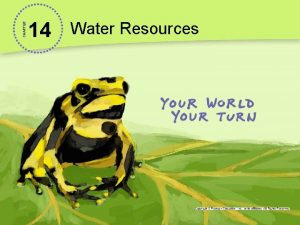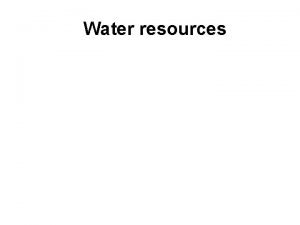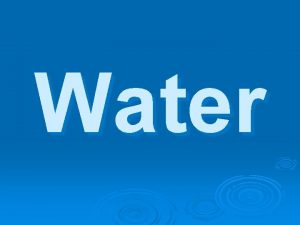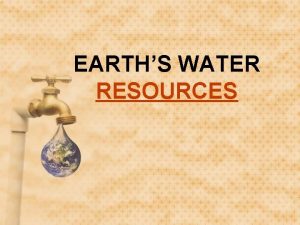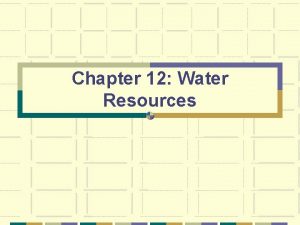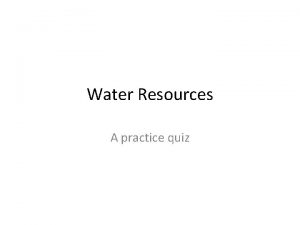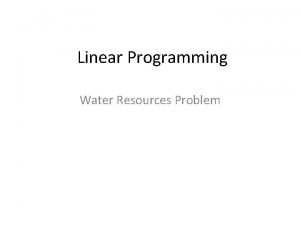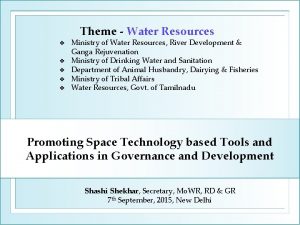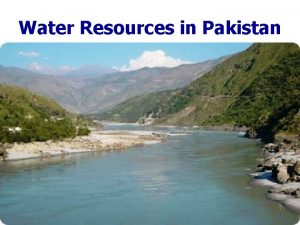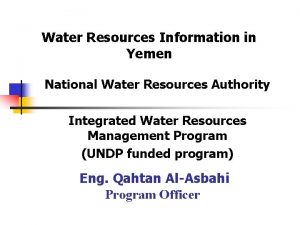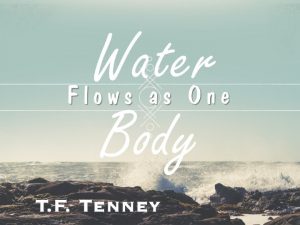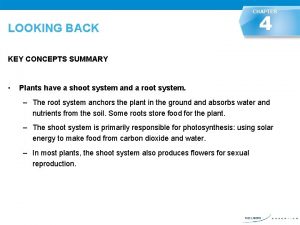CHAPTER 14 Water Resources Looking for Water in


































- Slides: 34

CHAPTER 14 Water Resources

Looking for Water. . . in the Desert • The 2300 -kilometer Colorado River once flowed deep and wide across the Southwest to Mexico’s Gulf of California. • Since the Colorado River Compact, in 1922, seven states— Arizona, California, Colorado, Nevada, New Mexico, Utah, and Wyoming—have relied on the river’s water for human use. • Today, drought, dams, and diversion have caused the once-raging Colorado River to run nearly dry. • Las Vegas, Nevada city officials have turned to an unlikely source for water—the desert. Their proposal to mine groundwater from beneath a scenic area of the Great Basin Desert is controversial. Talk About It Is the human need for fresh water reason enough to mine in an area that may threaten area ecology? What other ideas might states in the Colorado River Basin try?

Lesson 1. 1 Earth: The Water Planet Although the vast majority of Earth is covered in water, one in eight people lacks access to clean freshwater.

Lesson 14. 1 Earth: The Water Planet Earth’s Water • Fresh water is both a renewable resource and a limited resource.

Water is Limited • In order for water to be usable it needs to be freshwater as well as a liquid. • Water quality needs to be good. • Earth’s fresh water is distributed unequally. How much water people use depends on where they live and the time of year. Did You Know? If all Earth’s water were in a two-liter bottle, only about two capfuls would be fresh, liquid water.


Lesson 14. 1 Earth: The Water Planet Surface Water • Surface water includes still bodies of water and river systems. • A river system is a network of connected streams and rivers. Watersheds of the U. S. Did You Know? The Mississippi River Basin covers 3 million square kilometers (1. 2 million sq mi), making it the third largest watershed in the world. It drains 41% of the land area of the contiguous US. • Watersheds include all of the land area that supplies water to a river system. • Every waterway defines a watershed.

Maryland Watersheds

Watershed Activity • Water runs off the land ends up at the lowest elevation. • Each way we use the land correlates with different types of pollutants that can enter the river system. • To protect the health of our rivers, streams, tributaries, etc. we need to promote infiltration rather than runoff. • Buffers • Wetlands

Wetlands

Lesson 14. 1 Earth: The Water Planet Groundwater • Groundwater seeps through the soil and becomes contained in underground aquifers. • Aquifers are permeable layers of rock and soil that hold water (like a sponge). • The water table separates the zone of saturation from the zone of aeration. An Aquifer Did You Know? The average of groundwater is 1400 years. Groundwater recharges very slowly.

Lesson 14. 1 Earth: The Water Planet Groundwater Aquifers release 1. 9 trillion L (492 billion gal) of groundwater to the surface each day via springs (groundwater naturally reach the surface), geysers, and wells. • It takes 1400 – 10, 000 years to recharge an aquifer. • Old Faithful, a well-known geyser in Yellowstone National Park, shoots groundwater over 100 feet into the air many times a day. https: //www. youtube. com /watch? v=n 7 Knz 8 MHs. TU https: //www. youtube. com /watch? v=UPafz. YDUqr. A

Lesson 14. 2 Uses of Fresh Water One third of all the people on Earth are affected by water shortages.

Lesson 14. 2 Uses of Fresh Water How We Use Water • Three main uses of fresh water include: • Agricultural: irrigation, livestock • Industrial: manufacturing, energy industry • Personal: also called residential uses Did You Know? The average American uses 250 L of fresh water a day for personal uses, such as bathing and brushing teeth.

Lesson 14. 2 Uses of Fresh Water Using Surface Water • 77% of the freshwater used in the U. S. comes from surface water. • Surface water is diverted by canals and dams. • Dams create artificial reservoirs (store water for human use) • Drought and overuse have caused significant surface water depletion. Did You Know? The Aral Sea was once the fourth largest body of fresh water.

ater Diversion and Dam Examples • All American Canal: world’s largest irrigation canal • Hoover Dam created Lake Mead (reservoir)


Lesson 14. 2 Uses of Fresh Water Using Groundwater • 68% of groundwater in the U. S. is used for irrigation, most of which is very inefficient. • Groundwater mining turns groundwater into a nonrenewable resource because it is withdrawn from the ground faster than it can be replaced. • When groundwater is depleted, the falling water tables can cause cities to sink, and undrinkable saltwater to move into the depleted aquifers.


Lesson 14. 2 Uses of Fresh Water Solutions to Freshwater Depletion • Increase supply: • Desalination: “Making” fresh water by removing salt from saltwater. • Decrease demand: • Agricultural: Dripirrigation, climateappropriate plants • Industrial: Waterconserving processes, recycling wastewater to cool machinery. • Personal: Xeriscaping, water conservation Desalination

Activity • List the three main uses of freshwater. • For each category of water use, identify a way to conserve water. • Include pictures for each conservation idea.

Lesson 14. 3 Water Pollution 3, 800 children die every day from diseases associated with unsafe drinking water.

Lesson 14. 3 Water Pollution Types of Water Pollution • Point-source pollution: From a discrete location, like a factory or sewer pipe • Nonpoint-source pollution: From many places spread over a large area, such as when snowmelt runoff picks up pollutants along its path Point source oil pollution Oil after a spill, Trinity Bay, Texas

Lesson 14. 3 Water Pollution Nutrient Pollution • Excess phosphorous and other nutrients in the water is nutrient pollution. THE PROCESS OF EUTROPHICATION Nutrients build up in water. • Phosphorus is the limiting factor of plant growth in freshwater • Nitrogen is the limiting factor of plant growth in saltwater. • Nutrient pollution cause cultural eutrophication. • Most likely a nonpoint source of pollution Algae and aquatic plant growth increases. Organisms die. Decomposition requires oxygen. Dissolved oxygen levels decrease.


Maryland Coastal Bays

Lesson 14. 3 Water Pollution Toxic Chemical Pollution • Occurs when harmful chemicals are released into waterways • Most likely a point source of pollution • Can be organic (petroleum) or inorganic (heavy metals like arsenic, mercury and lead) • Harms ecosystems and causes human health problems

Lesson 14. 3 Water Pollution Sediment and Thermal Pollution • Sediment pollution: • Unusually large amounts of sediment that change an aquatic environment • Sediment pollution results from erosion. • Can degrade water quality, cause photosynthesis rates to decline, and disrupt food webs • Thermal pollution: • A heat source that raises the temperature of a waterway either from discharge from industry or cutting down vegetation that shades a water body. • Heated water holds less oxygen.

Lesson 14. 3 Water Pollution Biological Pollution • Biological pollution occurs when pathogens enter a waterway. • Biological pollution causes more human health problems than any other form of water pollution. • Water treatment reduces biological pollution. Cholera bacteria Did You Know? Giardiasis is the most common form of waterborne disease in the U. S.

Lesson 14. 3 Water Pollution Groundwater Pollution • Sources of groundwater pollution include natural sources, surface pollutants leaching through soil, and leaky underground structures. • Chemicals break down more slowly in groundwater than in surface water. • Most efforts to reduce groundwater pollution focus on prevention. Did You Know? The EPA repairs and replaces leaky underground gas storage tanks to reduce groundwater pollution. Over the last 25 years, over 1. 7 million tanks have been repaired or replaced. Acid drainage from a coal mine

Lesson 14. 3 Water Pollution Ocean Water Pollution • Oil pollution in the ocean comes from many widely spread small sources. Natural seeps are the largest single source. • Ocean organisms bioaccumulate mercury pollution. A 2004 oil spill off the Alaskan coast Did You Know? According to the U. S. Oil Pollution Act of 1990, by 2015, all oil tankers in U. S. waters must have double hulls to help prevent against leaks. • Nutrient pollution cause red tides. https: //www. youtube. com/watch? v=hfwmlps 0 Lco

Lesson 14. 3 Water Pollution Controlling Water Pollution • Government regulation decreases water pollution. • The Clean Water Act Lake Erie • Set water pollution standards • Required permits to release point-source pollution • Funded sewage treatment plant construction Did You Know? The Great Lakes show that humans can change their ways and clean up trouble spots. In the 1970 s, Lake Erie was declared “dead” but is now home to some flourishing species, especially the walleye.

Lesson 14. 3 Water Pollution Water Treatment • Drinking water is treated to remove pollutants before humans consume it. • Wastewater is treated to remove pollutants before humanused water is released back to the environment. Septic systems are the most popular method of wastewater disposal in rural areas of the U. S. https: //www. youtube. com/watch? v=tu. YB 8 n. MFx. QA

 Looking out, looking in summary
Looking out, looking in summary Looking out looking in chapter 9
Looking out looking in chapter 9 Water and water and water water
Water and water and water water What is transforming resources
What is transforming resources Fixed resources
Fixed resources Renewable vs nonrenewable resources worksheet
Renewable vs nonrenewable resources worksheet Chapter 14 water resources answer key
Chapter 14 water resources answer key Chapter 11 section 1: water resources answers
Chapter 11 section 1: water resources answers Chapter 4 landforms water and natural resources
Chapter 4 landforms water and natural resources Fspos vägledning för kontinuitetshantering
Fspos vägledning för kontinuitetshantering Typiska drag för en novell
Typiska drag för en novell Tack för att ni lyssnade bild
Tack för att ni lyssnade bild Returpilarna
Returpilarna Varför kallas perioden 1918-1939 för mellankrigstiden?
Varför kallas perioden 1918-1939 för mellankrigstiden? En lathund för arbete med kontinuitetshantering
En lathund för arbete med kontinuitetshantering Underlag för särskild löneskatt på pensionskostnader
Underlag för särskild löneskatt på pensionskostnader Personlig tidbok för yrkesförare
Personlig tidbok för yrkesförare A gastrica
A gastrica Densitet vatten
Densitet vatten Datorkunskap för nybörjare
Datorkunskap för nybörjare Tack för att ni lyssnade bild
Tack för att ni lyssnade bild Hur skriver man en tes
Hur skriver man en tes Autokratiskt ledarskap
Autokratiskt ledarskap Nyckelkompetenser för livslångt lärande
Nyckelkompetenser för livslångt lärande Påbyggnader för flakfordon
Påbyggnader för flakfordon Tryck formel
Tryck formel Publik sektor
Publik sektor Bo bergman jag fryser om dina händer
Bo bergman jag fryser om dina händer Presentera för publik crossboss
Presentera för publik crossboss Jiddisch
Jiddisch Bat mitza
Bat mitza Klassificeringsstruktur för kommunala verksamheter
Klassificeringsstruktur för kommunala verksamheter Mjälthilus
Mjälthilus Bästa kameran för astrofoto
Bästa kameran för astrofoto Centrum för kunskap och säkerhet
Centrum för kunskap och säkerhet
